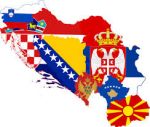WESTERN BALKANS
European Union institutions and member states defined the "Western Balkans" as the Southeast European area that includes countries that are not members of the European Union ( Serbia, Bosnia and Herzegovina, Montenegro, Kosovo, Macedonia and Albania — or Albania plus the former Yugoslavia, minus Croatia and Slovenia). Today, the Western Balkans is more of a political than a geographic designation for the region of Southeast Europe that is not in the European Union.
Most of the area is covered by mountain ranges running from north-west to south-east. The main ranges are the Balkan mountains, running from the Black Sea Coast in Bulgaria to its border with Serbia, the Rhodope mountainsin southern Bulgaria and northern Greece, the Dinaric Alps in Slovenia, Croatia, Bosnia and Herzegovina and Montenegro, the Šar massif which spreads from Albania to Macedonia, and the Pindus range, spanning from southern Albania into central Greece and the Albanian Alps. The highest mountain of the region is Rila in Bulgaria.
The Balkan region was the first area of Europe to experience the arrival of farming cultures in the Neolithic era. The practices of growing grain and raising livestock arrived in the Balkans from the Fertile Crescent by way ofAnatolia and spread west and north into Pannonia and Central Europe.
The identity of the Balkans is dominated by its geographical position; historically the area was known as a crossroads of cultures. It has been a juncture between the Latin and Greek bodies of the Roman Empire, the destination of a massive influx of pagan Bulgars and Slavs, an area where Orthodox and Catholic Christianity met, as well as the meeting point between Islam and Christianity.
The EU is the Western Balkans' largest trading partner, accounting for over two thirds of the region's total trade. As a whole the region's share of overall EU trade was 1% in 2013, however individual countries' shares were very low -Serbia 0,50%, Bosnia and Herzegovina 0,25%, FYR Macedonia 0,15%, Albania 0,10%, Montenegro 0,0% and Kosovo 0,0%.
In 2013, the EU's main imports from Western Balkans were machinery and transport equipment (24.1%), manufactured goods classified chiefly by materials (21.1%), and miscellaneous manufactured articles (20.3%), . The EU's exports to the Western Balkans were mainly machinery and transport equipment (26.9%), manufactured goods classified chiefly by material (22.3%), chemicals (15.2%), and mineral fuels (12.3%).
By clicking on the boxes below, you will find some delicate facts and figures about each country in the Western-Balkan region.


